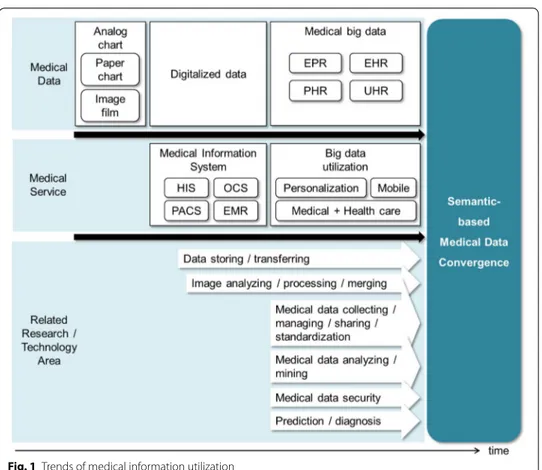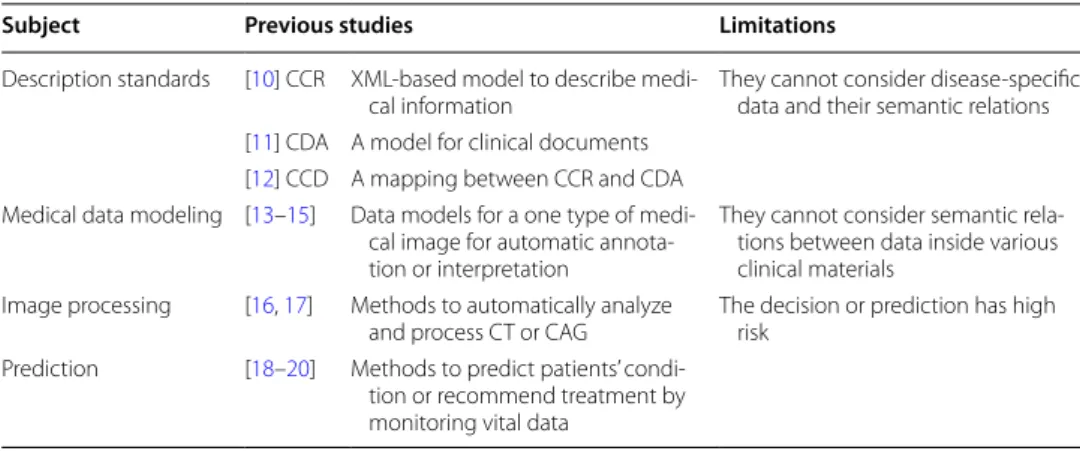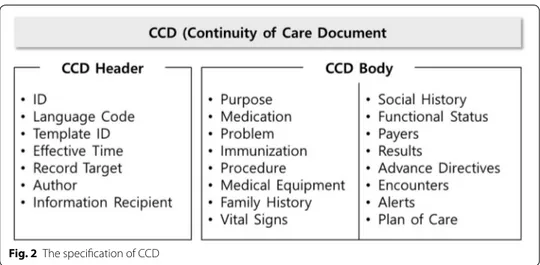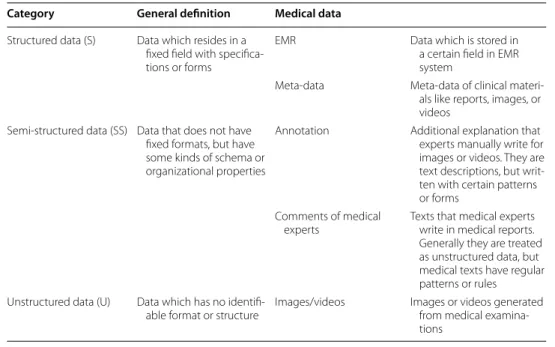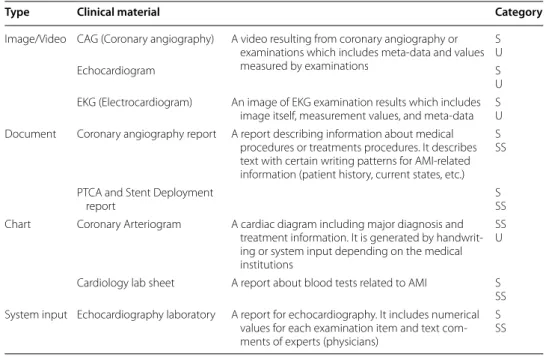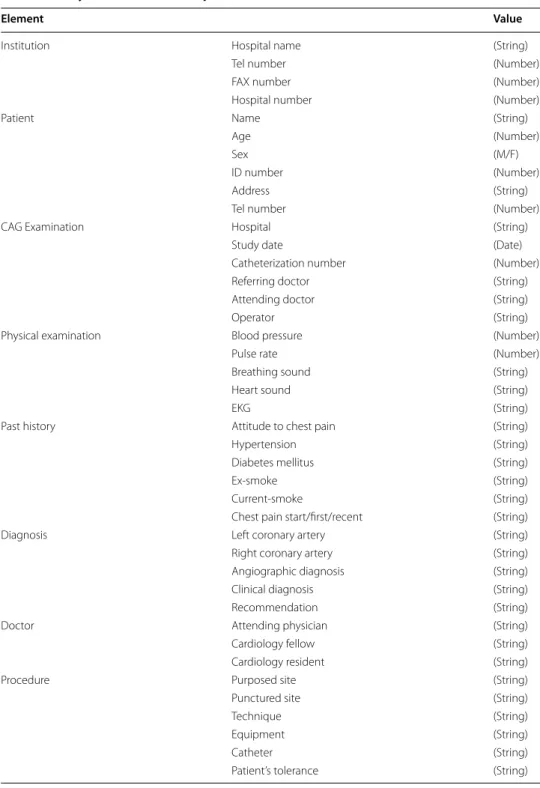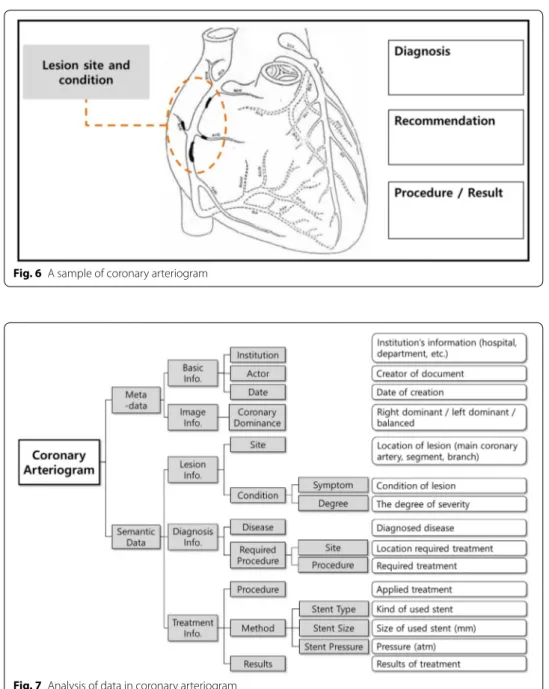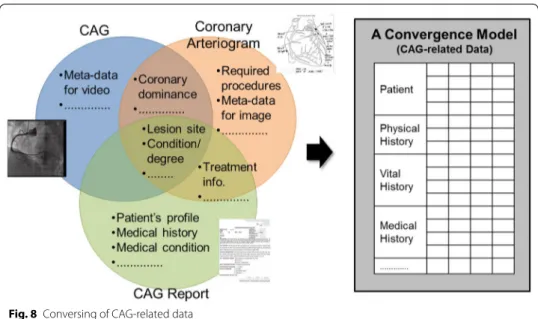A convergence data model for medical
information related to acute myocardial
infarction
Meeyeon Lee
1, Ye‑Seul Park
1, Myoung‑Hee Kim
2and Jung‑Won Lee
1*Background
Medical data is one of the big data, and its intelligent management and utilization have necessarily required. Figure 1 shows the trends of medical systems/services and related issues according to the changes of medical information. In the past, it was difficult to efficiently manage clinical information since most of them were generated and stored as paper charts or analogue films. In order to digitalize these medical data, many efforts have been taken for developing HIS (hospital information systems), OCS (order com-munication system), PACS (picture archiving and comcom-munication systems), and EMR (electronic medical record) systems for electronic charts and digital videos/images. After then, many studies [1–7] have aimed for efficient storing, sharing, and transferring electronic clinical materials, and some works [8, 9] have proposed methods to analyze and process individual clinical materials like medical images or videos.
Recently, rather than electronically storing clinical materials or processing each data, the needs for discovering meanings from medical big data and utilizing them have sig-nificantly increased. In particular, as some works have tried to use medical/health data and personal life-log for personalization services, the standardization of those data have been conducted. The international institutions realized the value of EPR (electronic patient record), EHR (electronic health record), PHR (personal health record), health
Abstract
Medical and health data has become accepted as the highly worthful and useful big data. However, the current medical information systems have aimed for digitalizaing, storing, and transferring clinical materials. Therefore, many experts assert the needs for the intelligent management and utilization of medical information. In this paper, in order to manage medical data which is separately stored in various materials, we attempt to define a convergence data model by analyzing characteristics and semantic relations of medical data. In particular, since essential clinical materials and medical data for the diagnoses and treatments depend on the kind of diseases, the proposed data model is applied to a target disease, AMI (acute myocardial infarction). Our model can contribute to the effective management and provision of medical data.
Keywords: Data model, Medical information, Data convergence, AMI (acute
myocardial infarction), CAG (coronary angiography)
Open Access
© 2016 The Author(s). This article is distributed under the terms of the Creative Commons Attribution 4.0 International License (http://creativecommons.org/licenses/by/4.0/), which permits unrestricted use, distribution, and reproduction in any medium, provided you give appropriate credit to the original author(s) and the source, provide a link to the Creative Commons license, and indicate if changes were made.
RESEARCH
*Correspondence: jungwony@ajou.ac.kr
1 Department of Electrical
and Computer Engineering, Ajou University, 206 Worldcup‑ro, Yeongtong‑gu, Suwon 16499, Republic of Korea
Full list of author information is available at the end of the article
data, UHR (universal health record). For describing those data, they have presented standards like CCR (continuity of care record) [10], CDA (clinical document architec-ture) [11], and CCD (continuity of care document) [12]. They provide the specifications for the exchange, sharing, and integration of electronic medical and health information. These standards support the management of general information and provide XML (extensible markup language)-based schemes. However, they cannot consider the dis-ease-specificity and cannot describe associative relations of data. That is, with the stand-ards, it is hard to describe details and semantic relations between heterogeneous data related to a specific disease. Furthermore, some works have actively tried for processing, mining, and overall managing big data in medical and health areas. And some studies have aimed for diagnoses of patients’ condition or prediction prognoses.
However, medical data and services have special and particular characteristics com-pared to other general big data areas. The purposes of general big data mining are to discover hidden meanings, to support decision-making, to recommend actions, and to predict the future by processing and analyzing data which is treated as useless. In con-trast, in medical fields, many experts are concerned about the risk and distrust of the analysis or decision by systems which are not human experts. Therefore, rather than the diagnosis or decision about treatments, an efficient provision and management of medi-cal data is more feasible and helpful for medimedi-cal experts. In other words, the technolo-gies of automating or replacing roles of physicians are less practical, and a method to manage clinical data is necessary so that experts can promptly search and refer related
data. It can be helpful to provide clinical data through various views based on their semantics, importance, and relations. Therefore, in this paper, we propose a semantic convergence method by analyzing characteristics and associations of heterogeneous medical data which is currently distributed in different systems.
Medical data generated in the medical fields is very vast in volume. As well as its types, formats, and attributes are heterogeneous depending on the medical departments and diseases. Medical data includes common parts such as a patient’s basic profile and vital information, but clinical materials (documents, examination results, etc.) are different in modality for diseases. One type of materials can contain data of various types, formats, properties, and significance. Besides, kinds and formats of one data depend on insti-tutions and medical experts (inspectors, physicians, and creators of materials). In our paper, we select a target disease to consider the disease-specific characteristics. Acute myocardial infarction (AMI) is an urgent disease that physicians should make a rapid decision about a patient’s condition and determine procedures from their information in the golden time. This target disease is proper and optimal to show the necessity and effects of our methods to converge heterogeneous medical data.
Therefore, in this paper, we propose a method for a semantic convergence and mode-ling of medical information. In particular, in order to consider the disease-specificity, we focus on AMI, since it is a critical disease that requires the efficient provision of essential parts among vast information for the quick decision in the golden time. The proposed method can extract semantic data which are distributed in various medical materials and unify them into one record.
Related works
In this section, we explain summarizations and limitations of previous works shor com-plete stop of the blood flow to the heartown in Table 1.
Standards for medical data
As personal health information including medical data has become increasingly impor-tant, related institutions like ASTM (American Society for Testing and Materials) and HL7 (Health level 7) have developed various standards for health records. The most representative standard CCR [10] is a XML-based standard to electronically describe
Table 1 Related works for describing and analysing medical information
Subject Previous studies Limitations
Description standards [10] CCR XML‑based model to describe medi‑
cal information They cannot consider disease‑specific data and their semantic relations [11] CDA A model for clinical documents
[12] CCD A mapping between CCR and CDA Medical data modeling [13–15] Data models for a one type of medi‑
cal image for automatic annota‑ tion or interpretation
They cannot consider semantic rela‑ tions between data inside various clinical materials
Image processing [16, 17] Methods to automatically analyze
and process CT or CAG The decision or prediction has high risk Prediction [18–20] Methods to predict patients’ condi‑
tion or recommend treatment by monitoring vital data
patients’ health information. It consists of three core components, the CCR Header, the CCR Body, and the CCR Footer. The CCR Header defines basic information (unique identifier, creation date, etc.) for documents or records, and the CCR Footer describes additional information. The core part, the CCR Body, contains patient-specific signifi-cant information such as medical problem (date, condition, etc.), family history (blood type, genetic relatives, etc.), social factor (life pattern, environmental factors, etc.), aller-gies, medication, and so on.
CDA [11] is a document markup standard for the structure and semantics of clinical documents. It provides a kind of a template for clinical documents and comprises two parts. The CDA Header contains basic elements for a CDA document like its type and provider. The CDA body specifies all the sections of the health record such as diseases, medical procedure, plan of care, and so on.
CCD [12] is a specification resulting from a collaborative effort between ASTM and HL7. It maps the CCR elements and CDA elements. Figure 2 shows a summarization of CCD standard which is similar to CCR or CDA elements.
These standards for medical and health information have strengths that they can cover a wide range of general health information and represent them as XML-based forms. However, they cannot describe detailed data for a specific disease and lack flexibility in their specification. Moreover, they cannot consider semantic relations between data ele-ments. In other words, with the standards, it is difficult to represent specific data related to a certain disease like AMI and semantic associations between heterogeneous data.
Analysis of medical data
In the past, many studies have been constantly conducted to generate medical data models and semantically interpret or analyze them. Especially, some of them have pre-sented data models for describing semantic data embedded in videos/images which are one of the most important medical materials [13–15]. They proposed ontology schemas by extracting characteristics of medical videos or images and tried to develop systems for annotations or automatic extraction of semantics. However, since they just focused on one type of clinical materials, they did not consider heterogeneous data in EMR or PACS. In recent years, some works have started to construct domain knowledge bases
from semantic relations of data stored in medical information systems like EMR [16]. However, those works focused on automatically finding relations of symptoms and dis-orders. Therefore, studies on efficient providing methods of medical data by converging of heterogeneous data are still insufficient.
In studies of cardiac diseases which are the target domain of this paper, some works have aimed at automatically processing or analyzing videos of CT (computed tomog-raphy) or angiography [17, 18]. Also, some systems have been developed in order to inform patients’ conditions to medical experts, to recommend required treatments, or to predict prognoses [19, 20]. However, these works considered a single kind of medi-cal data and applied statistimedi-cal analyses or rule-based mining to fragmentary data of patients’ current conditions. Those decision or diagnosis systems have little practicality in real medical institutions.
Data analysis for AMI
Acute myocardial infarction (AMI) is a disease known as a heart attack which occurs when the coronary arteries become blocked or narrowed due to a buildup of plaque. This can cause a significant decrease or complete stop of the blood flow to the heart. In the case of AMI, a correct diagnosis and treatment should be done within 90 min at most and its total time has direct effects on a prognosis and a rate of death. Therefore, systems should be able to provide and manage essential data required in emergency so that medical experts can make a quick decision. However, in the current HISs, the scope and kinds of data that experts can check depend on the institutions’ cooperation or phy-sicians’ capability since medical data for one patient is separately stored and managed by institutions and kinds of data. These management methods can cause fatal results in emergency of AMI.
In this paper, for converging of medical information, we collected important clinical materials related to AMI, extracted semantic data from individual materials, and defined one data record based on their associative relations.
First of all, in order to enhance the reality or practicality of our data model, we col-lected materials which are actually used at four general tertiary hospitals in Korea. Then, we selected eight types of materials commonly used. Our samples contain four types of images/videos, two types of reports, and two types of examination result reports.
Categorization of medical data
As mentioned in the introduction section, the modeling of data contained in clinical materials is necessary for intelligent utilization of medical information. Before defining a data model, it is necessary to analyze types and characteristics of data which are gen-erated and used at medical institutions. Therefore, in this section, we define the scope, kinds, and properties of clinical data which should be included in our convergence model by classifying them according to the degree of structuration.
In general, data can be categorized into three types: structured, semi-structured, and unstructured data. Table 2 shows a categorization of medical data with these criteria. The classification of medical data is different from general definitions due to the charac-teristics of medical fields. In general domains, most of text data is classified as unstruc-tured data, but text descriptions in clinical materials can be treated as semi-strucunstruc-tured
data because they are written with regular patterns or formats. That is, medical experts usually use specific words or styles of sentences when they write annotations or com-ments. These medical data are stored in EMR systems and PACS. However, since the systems separately manage these data, they do not consider their relations, and experts have to manually search and check individual materials. For example, even though clini-cal materials like charts, videos generated by coronary angiography, and examination reports for a patient contain similar information, they are stored in different systems and managed by a patient ID without considering semantic relations.
Analysis of AMI‑related data
In order to reflect the disease-specificity in a data model, we collected and analyzed eight clinical materials which are essential for the diagnoses and treatments of AMI. As shown in Table 3, they consist of four types of materials, and one material contains data of various formats.
• System input materials generated by entering data in fixed fields in electronic systems of hospitals. Most of them contain structured data.
• Document various reports which include both of structured data and semi-struc-tured texts.
• Image/video images or videos resulting from medical examinations. Images or videos themselves are unstructured data, but they also include structured data like measure-ment values and their meta-data.
• Chart analogue or digital charts that medical experts write or draw data by hand-writing or using systems. These charts can have all types of data.
Among these materials, we focus on three types grayed in Table 3 and analyze each material to extract and unify their data based on semantic relations. These materials are
Table 2 Structure-based categorization of medical data
Category General definition Medical data
Structured data (S) Data which resides in a fixed field with specifica‑ tions or forms
EMR Data which is stored in
a certain field in EMR system
Meta‑data Meta‑data of clinical materi‑ als like reports, images, or videos
Semi‑structured data (SS) Data that does not have fixed formats, but have some kinds of schema or organizational properties
Annotation Additional explanation that experts manually write for images or videos. They are text descriptions, but writ‑ ten with certain patterns or forms
Comments of medical
experts Texts that medical experts write in medical reports. Generally they are treated as unstructured data, but medical texts have regular patterns or rules Unstructured data (U) Data which has no identifi‑
able format or structure Images/videos Images or videos generated from medical examina‑ tions
related to CAG (coronary angiography) which is an essential medical examination for diagnosis and treatment of AMI.
The first clinical material shown in Fig. 3 is a coronary angiography. The sample is shown as captured images in Fig. 3, but it is a video type resulting from medical exam-ination. We can define two groups of data which can be extracted from this material shown in Fig. 4. A group of metadata is properties of a video such as performing date, angles, and so on which are automatically attached when it is created. Semantic data means information which is supposed to be interpreted by medical experts. In other words, this group includes the location and condition of a lesion in terms of the main coronary artery, or its segments or branches.
Table 3 AMI-related clinical materials
Type Clinical material Category
Image/Video CAG (Coronary angiography) A video resulting from coronary angiography or examinations which includes meta‑data and values measured by examinations
S U
Echocardiogram S
U EKG (Electrocardiogram) An image of EKG examination results which includes
image itself, measurement values, and meta‑data SU Document Coronary angiography report A report describing information about medical
procedures or treatments procedures. It describes text with certain writing patterns for AMI‑related information (patient history, current states, etc.)
S SS PTCA and Stent Deployment
report SSS
Chart Coronary Arteriogram A cardiac diagram including major diagnosis and treatment information. It is generated by handwrit‑ ing or system input depending on the medical institutions
SS U Cardiology lab sheet A report about blood tests related to AMI S SS System input Echocardiography laboratory A report for echocardiography. It includes numerical
values for each examination item and text com‑ ments of experts (physicians)
S SS
The second material is a coronary angiography report. It is a document which contains not only structured data like a patient’s information (age, gender, etc.) and date, but also semi-structured data. The large portion of this report is text, but they are written in typi-cal patterns to mention a patient’s meditypi-cal history, smoking habit, and symptoms. For the commonality of a data model, we created a template by extracting common factors from reports of four institutions. Figure 5 shows a sample template and Table 4 shows extracted data of the report.
The final material is a coronary arteriogram shown in Fig. 6 which can describe essen-tial information about the diagnoses, treatment procedures, and progress. In many hos-pitals, physicians use this material to mark the specific site and severity of lesions on a simplified map of coronary artery related to AMI. This material contains significant data depicted in Fig. 7.
Data convergence modeling for AMI
As analyzing three materials in the previous section, they contain heterogeneous and redundant data. In addition, even though those data are semantically related to each other, they are distributed in different materials. That is, as shown in Fig. 8, information
related to AMI is dispersed into three kinds of materials. However, some of data are duplicated and semantically associated with each other. Therefore, a new method is nec-essary to semantically converge and manage medical data instead of clinical materials like documents and images/videos. Table 5 shows the proposed data model for AMI defined by converging CAG-related materials of three types. That is, the specification can support to describe data which are stored in a video, a document, and an image of the current HISs.
The data record includes essential elements about the diagnosis and treatment and consists of four groups as follows:
• Patient a patient’s basic information such as personal information and coronary ana-tomical information, etc.
• Physical history a patient’s states or habits which have a strong influence on AMI. • Vital history a patient’s basic medical states related to AMI.
• Medical history information about the past diagnoses or treatments related to AMI. That is, this part includes locations and states of lesions, disease names about past diagnoses, and results of treatments.
In the current EMR systems and PACS, these data associated with each other are con-tained in heterogeneous materials. On the contrary, the convergence model shown in
Table 5 can provide and manage essential information as a single record. Moreover, each data element is described with following properties shown in Table 6:
• Creator medical experts (physicians, inspectors, etc.) or institutions who created and modified each element.
• Date the date on which creators created and changed the value of each element.
Table 4 Analysis of data in CAG report
Element Value
Institution Hospital name (String)
Tel number (Number)
FAX number (Number)
Hospital number (Number)
Patient Name (String)
Age (Number)
Sex (M/F)
ID number (Number)
Address (String)
Tel number (Number)
CAG Examination Hospital (String)
Study date (Date)
Catheterization number (Number)
Referring doctor (String)
Attending doctor (String)
Operator (String)
Physical examination Blood pressure (Number)
Pulse rate (Number)
Breathing sound (String)
Heart sound (String)
EKG (String)
Past history Attitude to chest pain (String)
Hypertension (String)
Diabetes mellitus (String)
Ex‑smoke (String)
Current‑smoke (String)
Chest pain start/first/recent (String)
Diagnosis Left coronary artery (String)
Right coronary artery (String)
Angiographic diagnosis (String)
Clinical diagnosis (String)
Recommendation (String)
Doctor Attending physician (String)
Cardiology fellow (String)
Cardiology resident (String)
Procedure Purposed site (String)
Punctured site (String)
Technique (String)
Equipment (String)
Catheter (String)
• Importance the level of significance of each element. This property can have grades depending on whether the element is essential for the diagnosis and treatment, or on the degree that it influenced AMI.
• Reference-metadata metadata for ‘reference’ elements of a ‘Medical History’ group. This property represents metadata of related materials (documents, images/videos, etc.) such as equipment models and angles of examinations.
Fig. 6 A sample of coronary arteriogram
The proposed data model shown in Table 5 can be a foundation to efficiently manage and promptly provide information which is crucial for a decision of diagnoses and treat-ments, particularly in the case of urgent diseases.
Conclusion
Data generated in medical fields are vast in volume and heterogeneous in terms of types, formats, and characteristics. However, the current HISs just store these data in differ-ent documdiffer-ents and images/videos. Therefore, it is difficult to efficidiffer-ently provide relevant data in the golden time when experts need to view essential data for decision about urgent diseases like AMI. In order to usefully manage these data, a new data model should be defined based on the analysis of characteristics and semantic relations of data included in heterogeneous materials. In this paper, we proposed a convergence model to specify data which are essential for the diagnoses of AMI by analyzing three materials related to CAG. In contrast with the current HISs, the proposed model can unify seman-tic data contained in various materials as a single record. The convergence record will enable medical experts to easily and intuitively search important data for quick decision about diagnoses and treatments.
Starting with the convergence model proposed in this paper, we have a plan to con-sider the following challenging issues or future works:
• Improvement of the convergence record in order to enhance the coverage and com-pleteness of our data model, we will extend and refine its elements by analyzing all of essential materials.
Table 5 A convergence model of three types of CAG-related data for AMI
Element
Patient Basic profile Name
Age Sex Address Tel number Cardiac profile Coronary dominance Physical history Pain
Hypertension Diabetes mellitus Ex‑smoke Current‑smoke
Chest pain start/first/recent Vital history Blood pressure
Pulse rate Breathing sound Heart sound EKG
Medical history Diagnosis Actor
Lesion Site
Condition Symptom
Degree Disease Disease name
Required/recommended procedure Target site Procedure name Reference
Medical
Treatment Procedure ActorProcedure name target site Technique Equipment Patient’s condition Result Reference
• Verification it is necessary to examine the feasibility or applicability of the data model to the HISs through medical experts.
• Implementation and experiment we will implement a medical data provision and management system applying the model and will qualitatively and quantitatively compare its efficiency with the current HISs.
Table 6 Properties for elements in a record
Property Creator Date Importance
Reference‑metadata Common Reference Reference ID
Reference name Reference type Patient Patient ID Patient name Actor Institution Date Cross reference
Partial CAG Equipment model
Operator
Axis Rotation RAO
LAO angulation Cranial
Caudal
Authors’ contributions
Author ML, YSP, MHK and JWL are responsible for the concept of the paper, the results presented and the writing. All authors read and approved the final manuscript.
Author details
1 Department of Electrical and Computer Engineering, Ajou University, 206 Worldcup‑ro, Yeongtong‑gu, Suwon 16499,
Republic of Korea. 2 Department of Computer Science and Engineering, Ewha Womans University, 52, Ewhayeodae‑gil,
Seodaemun‑gu, Seoul 03760, Republic of Korea. Acknowledgements
This work was supported by Institute for Information & communications Technology Promotion (IITP) Grant funded by the Korea government (MSIP) (No.B0101‑15‑247, Development of Open ICT Healing Platform using Personal Health Data).
Competing interests
The authors declare that they have no competing interests. Received: 17 January 2016 Accepted: 29 June 2016
References
1. MacKinnon W, Wasserman M (2009) Implementing electronic medical record systems. IT Prof 11(6):50–53. doi:10.1109/MITP.2009.125
2. Jeun Y‑J (2013) EMR system and patient medical information protection. Korean J Health Serv Manage 7(3):213–224. doi:10.12811/kshsm.2013.7.3.213
3. Zhao C, Zhang L (2013) Research of information presentation for electronic medical record based on ontology. In: Proceeding of the 2013 international conference on information management, innovation management and industrial engineering, pp. 489–492. doi:10.1109/iciii.2013.6703628
4. Na H‑S, Yun S‑Y, Park S‑C (2012) Design and implementation of mapping system for effective health information data exchange in multi‑platform environment. J Korean Inst Inf Technol 10(12):143–150
5. Perera S, Henson C, Thirunarayan K, Sheth A, Nair S (2014) Semantics driven approach for knowledge acquisition from EMRs. IEEE J Biomed Health Inform 18(2):515–524. doi:10.1109/JBHI.2013.2282125
6. Greenspan H, Pinhas AT (2007) Medical image categorization and retrieval for PACS using the GMM‑KL framework. IEEE Trans Inf Technol Biomed 11(2):190–202. doi:10.1109/TITB.2006.874191
7. Tao Y, Peng Z, Krishnan A, Zhou XS (2011) Robust learning‑based parsing and annotation of medical radiographs. IEEE Trans Med Imaging 30(2):338–350. doi:10.1109/TMI.2010.2077740
8. Valente F, Viana‑Ferreira C, Costa C, Oliveira JL (2012) A RESTful image gateway for multiple medical image reposito‑ ries. IEEE Trans Inf Technol Biomed 16(3):356–364. doi:10.1109/TITB.2011.2176497
9. Alvarez LR, Vargas Solis RC (2013) DICOM RIS/PACS telemedicine network implementation using free open source software. IEEE Lat Am Trans 11(1):168–171. doi:10.1109/TLA.2013.6502797
10. ASTM International (2012) ASTM E2369‑12: standard specification for continuity of care record (CCR) doi:10.1520/ E2369‑12
11. Health Level 7 International. HL7 implementation guide for CDA release 2. http://www.hl7.org/implement/stand‑ ards/product_brief.cfm?product_id=7. Accessed 16 Jan 2016
12. Health Level 7 International (2007) HL7 implementation guide: CDA release 2—continuity of care document (CCD) 13. Mhiri S, Despres S, Zagrouba E (2008) Ontologies for the semantic‑based medical image Indexing: an overview. In:
Proceeding of the international conference on information and knowledge engineering, pp 311–317
14. Iakovidis DK, Schober D, Boeker M, Schulz S (2009) An ontology of image representations for medical image mining. In: Proceeding of the international conference on information technology and applications in biomedicine, pp 1–4 doi:10.1109/itab.2009.5394373
15. Rubin DL (2012) Finding the meaning in images: annotation and image markup. Philos Psychiatry Psychol 18(4):311–318. doi:10.1353/ppp.2011.0045
16. Kim S‑H, Lee J, Kim J‑H, Lee H‑W, Jung W‑G, Lee G‑K (2011) Insertion path extraction of catheter for coronary angi‑ ography. J Korea Ins Inf Commun Eng 15(4):951–956. doi:10.6109/jkiice.2011.15.4.951
17. Rivest‑Henault D, Sundar H, Cheriet M (2012) Nonrigid 2D/3D registration of coronary artery models with live fluoroscopy for guidance of cardiac interventions. IEEE Trans Med Imaging 31(8):1557–1572. doi:10.1109/ TMI.2012.2195009
18. Park SH, Park HA, Ryu KS, Kim H, Ryu KH (2012) A long‑term mortality prediction model for patient with ST‑segment elevation myocardial infarction using decision tree. In: Proceeding of the Korea Computer Congress 1(C), pp 139–141
19. Martinez‑Romero M, Vazquez‑Naya JM, Pereira J, Pereira M, Pazos A, Banos G (2013) The iOSC3 system—using ontologies and SWRL rules for intelligent supervision and care of patients with acute cardiac disorders. Comput Math Method M. doi:10.1155/2013/650671
20. Lee JH, Jeong MH, Rhee JA, Choi JS, Park IH, Chai LS, Jang SY, Cho JY, Jeong HC, Lee KH, Park K‑H, Sim DS, Kim KH, Hong YJ, Park HW, Kim JH, Ahn Y, Cho JG, Park JC (2014) Factors influencing delay in symptom‑to‑door time in patients with acute ST‑segment elevation myocardial infarction. Korean J Med 87(4):429–438. doi:10.3904/ kjm.2014.87.4.429
